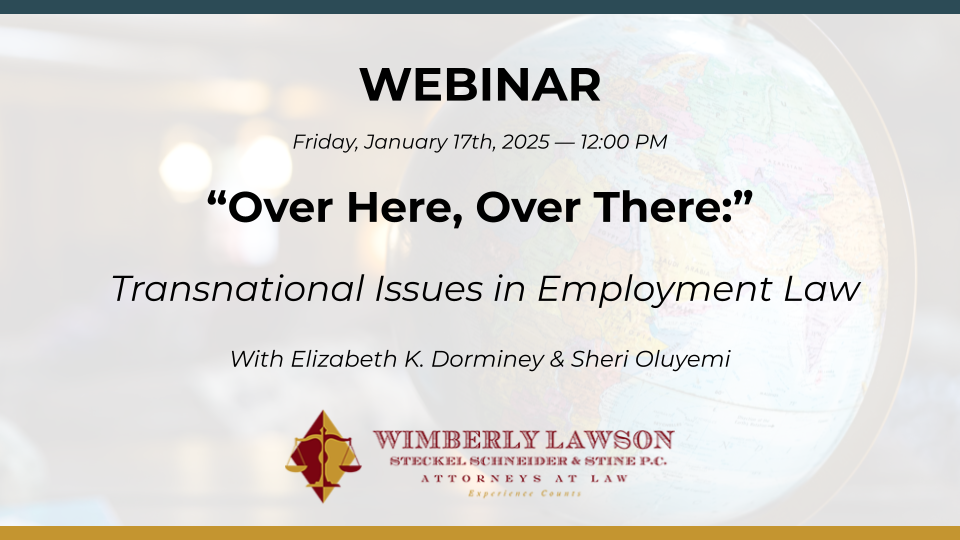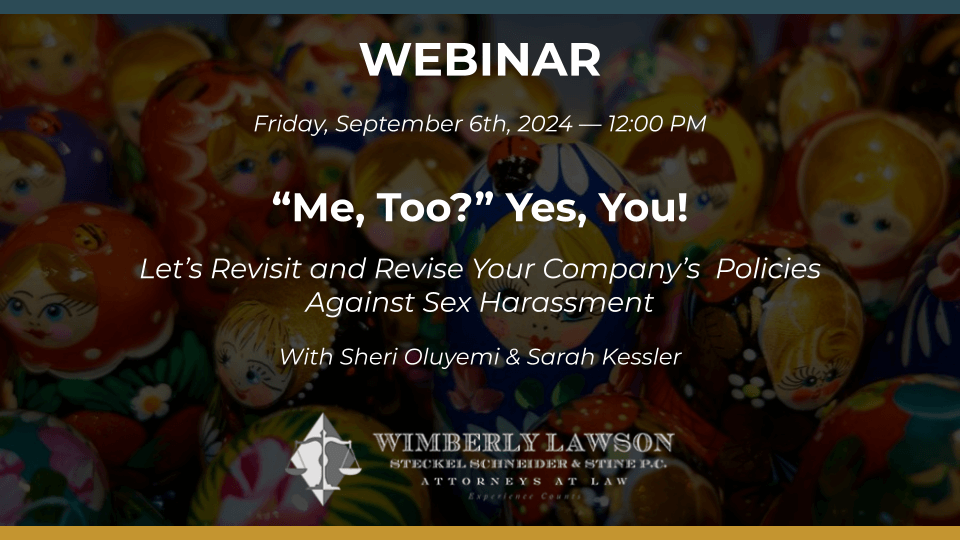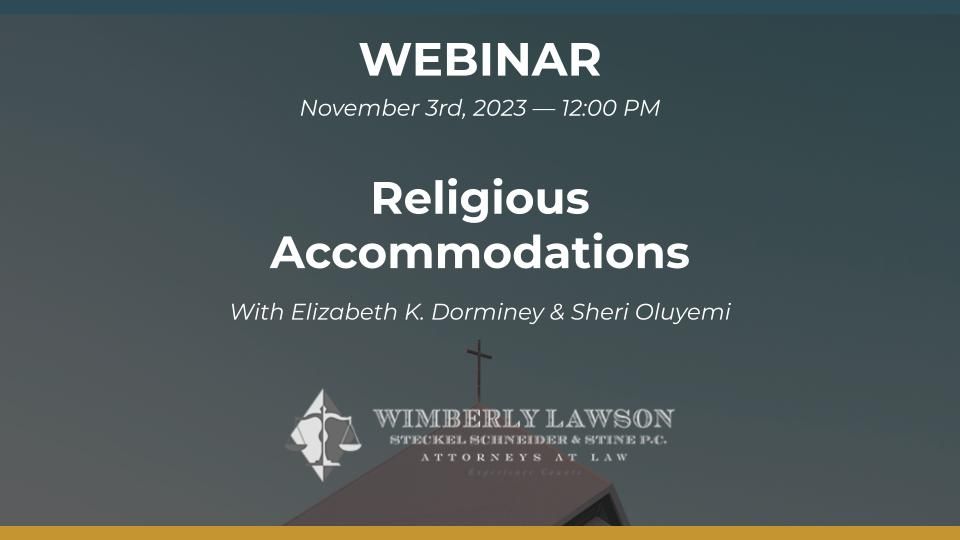
“Over Here, Over There:” Transnational Issues in Employment Law
This seminar will explore aspects of US labor and employment law that sometimes do, and sometimes don’t, stop at the water’s edge. For just one example, a worker assigned outside our territorial boundaries isn’t entitled to overtime and other benefits of the Fair Labor Standards Act (though local laws may entitle them to other benefits and protections). We also will explore several nonimmigrant visa programs like the H-1A and H-1B that allow US employers to hire workers from outside the US for certain kinds of jobs. Who can use these visa programs, and when, and how? This issue has been in the news lately, and our experts will be on hand to answer your questions.
Watch This Webinar
Webinar Transcript
Elizabeth K. Dorminey (00:00):
Welcome everybody. The disembodied voice you hear is mine. I'm, my name is Betsy Dorminey, and I'm one of the partners at Wimberley Lawson. Our subject for today's webinar is over here, over there, and the subtitle is What Stops at the Border and What Does Not with the US Employment Laws. So we're going to talk today about certain aspects of US labor laws that sometimes do and sometimes don't stop at the water's edge. For example workers in most circumstances who work for, but are assigned to work outside the United States, territorial boundaries aren't entitled to overtime and the other benefits of the Fair Labor Standards Act. Although that doesn't mean you're completely off the hook because the country in which your employee is working may require you to extend benefits that may be even more generous than those afforded by the FLSA in terms of overtime and wages and so forth.
Elizabeth K. Dorminey (01:05):
These are, these are issues that come up in this global age of Zoom and electronics where people can work remotely and do for many, for, for many many different many different kinds of, of professions. The notice for this webinar said that our colleague Sherry Ole, would be working on it, but unfortunately she was called away. And so our resident immigration law expert, Jim Hughes, is going to talk in the second half of the program about some of the Visa programs like the H two A and the H two B that have been in the news recently, and explain to you how those really work, because as we know, the six o'clock news doesn't always get all the details right. There are questions like, is this a, a great way for us companies to save a whole bunch of money and pay under market wages to workers that are brought in from outside?
Elizabeth K. Dorminey (02:01):
And the answer to that, I'm pretty sure Jim is gonna confirm, is not necessarily but who can use these visas and what they cover, what kind of jobs and how are subjects that Jim is going to address in, in a little bit. So let me start off with, oh, also I want to be sure that you know that if you have questions as you're going along make a note. And we do have the facility on Jim's end to invite people to, to ask questions either through chat, I believe, or audio when we, when we get to that point of the program. So let me start off with the Fair Labor Standards Act which is our main employment Employee Protection Law. And this, I'm sure all of you know, it covers things like minimum wages and overtime, but there is a special section of the exemptions, which states specifically that the FLS a's main provisions do not apply with respect to any employee whose services during the work week are performed in a workplace within a foreign country or within territory under the jurisdictions of the United States, other than a list of places like the District of Columbia, Puerto Rico, Virgin Islands, and so on and so forth.
Elizabeth K. Dorminey (03:25):
Now, the important concept here which of course we come back to time and again with the Fair Labor Standards Act, is that it's done on a work week by work week basis basis. So if you have a US employee who is sent to, oh, wherever it might be, England, for example, for a one month, two month, one week, two week period the Fairly Labor Standards Act is going to look at it on a week by week basis. And on those work weeks where the work is being performed outside the United States, your employees are not entitled to the FLSA protections. But the other flip side of that, of course, is to remember that if an employee who is habitually assigned to work outside the United States comes home, then when they're at the home office if they're entitled to overtime, they will be you know, if they're, they're, they'll be covered under the FLSA.
Elizabeth K. Dorminey (04:28):
Most employer employees and employees who find themselves in that situation are gonna be dealing with salaried people at any, at any rate because the level of work being done. But that's, that's just something to bear in mind that <inaudible> determination, LSA works this exemption covers minimum wage over time investigations by the US Department of Labor and Hot Goods issues. So those are the things that arise when in the enforcement on the enforcement side of the program, when the Department of Labor takes action against an employer whom they alleges failing to pay its employees as required under the FLSA, and they put an embargo on the production of that employer until such time as, as the matter's resolved. That's a potentially very powerful weapon that the US Department of Labor doesn't use often, but it really has a lot of impact when they do use it.
Elizabeth K. Dorminey (05:32):
But again, for purposes of our discussion today, it's, it's, it's not applicable to work that happens outside the United States. Now, there was a very interesting case a few years ago that covered in, in essence it covered a child labor claim. The the Nestle Company got in trouble because they were alleged to be employing children in oppressive situations under out in the Ivory Coast, which is on the the, the western coast of, of Africa. And the there was a suit brought under the alien tort statute, which allows people to go into US courts to pursue wrongs or seek remedies against well, it's a little ambiguous who they can seek remedies against, but they were going against the, the Nestle company there. So it wasn't specifically a child labor case, but in the final analysis, the Supreme Court determined in I believe it was 2020 that the 2021 actually that because everything that was happening was happening outside the United States, they they did not have enough to establish a violation of, of US law under the circumstances.
Elizabeth K. Dorminey (07:01):
So that's just to say that these, these things can come up in some kind of surprising context. The FLSA has specific regulations also five CFR 5 51, 1 0 4, that exempts the geographic area from coverage under when it's, you know, outside the us it's the same territories that we're listed up above. Another law that we see come up frequently, the fair the Family Medical Leave Act, FMLA like the FLSA, applies only to employees who are employed within the United States and the territories that are listed there, but it does not apply to employees who are working outside the us. And similarly, the Occupational Safety and Health Act doesn't apply outside the United States and its territories. Section 90 19 81, which prohibits race discrimination. This is called reconstruction era amendments does not apply outside the United States, but things like Title VII and the A DEA Age Discrimination and Employment Act Americans with Disabilities Act may apply if you have a US employer.
Elizabeth K. Dorminey (08:26):
So those are things to be to be aware of as you are contemplating where to, where to put your people and how to treat them. So remote work considerations. There's, there's a lot of things to consider that are not just limited to US law, but also touch and concern the laws of the other countries where you are. Labor and employment laws are, are kind of, lawyers are kind of a broken record on this, but it's always important and even more important in this kind of a situation to have a written agreement of employment with your employee who's going to be working outside the US that specifies the choice of law and selects a forum for any dispute to be regulated. And the forum for the dispute can be can be arbitration or rather than access to the federal courts, although you may run into some issues with the country in which the worker is employed, because they may not they may not recognize arbitration as an alternative.
Elizabeth K. Dorminey (09:36):
Things like work authorization have to be determined under local laws, and it's important to ascertain what other local protections and requirements might cover your workers. For example, we had a case not too long ago where there was a, an employee of a US company who was being assigned to work in Dubai. And I was interested to learn that Dubai prescribes an employment contract and requires that there be a written contract of employment with every foreign employee who is going to be working in Dubai. There are fees to be paid locally for processing and so forth. The contract also required the employer to assure that health insurance was provided for the employee because they don't want somebody to become a charge on, on their state if they're injured or ill, and also required explicitly that they be that their return home flight or travel be assured by the employer.
Elizabeth K. Dorminey (10:42):
So that was a, an interesting an interesting aspect of, of foreign employment that we wouldn't necessarily think of, but it's just an example of the kinds of things that may be required in another country, even though they're not required in the US and a US employer with an employee in that other part of the world is going to be required to comply with the local rules. Termination of employment can be an interesting issue in the US of course, mostly we follow an at will notion of employment that people can you know, say goodbye and part company without too much formality. But many other countries place a lot of restrictions on an employer's ability to discharge a worker. They you know, they may have a requirement as did Dubai for a specific contract of employment that's going to cover the employee for a certain period of time.
Elizabeth K. Dorminey (11:43):
So these are, you know, these are some of the things that that you, you would need to be considering should you have a, a US worker who is working at an, at an establishment outside the United States, or even just a, you know, a a half laptop will travel type worker who works remotely, and you may not know exactly where they're going to be at any given time. So with that <inaudible>, I'm going to pass porch to Mr. Hughes and let him tell you something about some of the requirements or the burdens and so forth associated with bringing workers from outside the United States in.
James L. Hughes (12:30):
I want to talk about H two A, H two B, and H one B. The program description referenced H one A, which was no longer used since 1999, but H one b, H two A and H two B are still commonly used. Today. H two B is for temporary non agricultural workers. Let's go with non-agricultural workers first. To qualify for H two B status, the petitioner must establish that there are not enough US workers who are able, willing, qualified, and able available to do the work in the United States. They also have to establish that employing H two B workers will not adversely affect the wages and working conditions of similarly situated US workers.
James L. Hughes (13:39):
And the employment has to be temporary. But for H two B workers, it can be a, a one-time occurrence. Say you're a poultry processor and your plant is rated by the US government and half your workforce is taken because they were not authorized to work in the United States. Then you, you may want to seek H two B workers on a one-time occurrence basis and, and bring them into the United States to build jobs in your plant. H two B is also available on a seasonal need basis. You can, if, if you have a seasonal pattern or need in your workforce, then you might be able to rely on H two B workers. For example, H two B workers are commonly used in hotels and theme parks and that sort of, those sorts of places because they are busier during certain seasons of the year. You, you might have a peak load need. Persons who, or employers who have a peak load can sometimes request an employee H two B workers,
James L. Hughes (15:13):
Or you may have an intermittent need. In this situation, you must show that you have not employed permanent or full-time workers to perform the services or labor, and that it's an intermittent need to bring in temporary workers. There is a cap on the number of H two B workers who are newly admitted each year, and that cap is 66,000. 33,000 are allowed during the first part of the government's physical year, and 33,000 are allowed during the second half of the government's fiscal year. There are H two B workers who are exempt from the cap and usually once you bring in H two B workers, you can keep bringing them in year after year because they would likely be exempt from the H two B cap. There is a process you have to submit a temporary labor certification application to the Department of Labor, and the Department of Labor has to approve that request.
James L. Hughes (16:42):
And there's all kinds of requirements, <laugh> that you have to satisfy with the Department of Labor. In order to bring a person in, most specifically, the wage and benefits that you will offer the worker, they must be shown to be consistent with what is available to US citizens in the area of employment. If you are able to obtain a temporary labor certification, then you submit a petition to the government and specifically the United States Citizenship and Immigration Service you will file a form and with limited exceptions you submit the original Labor certification along with your I 1 29 out. The prospective workers, if your application is approved, would then then apply for visas outside the United States in order to come in to the United States. With respect to H two B, there is a specific requirement prohibiting the collection of fees like job placement fees or breach of contract penalties and that sort of thing when you're dealing with H two B employees. And you can have your petitions denied if fees are being charged to your H two B workers. Generally, the workers are authorized to stay in the United States for the period listed on their H two B Visa the maximum period of stay, and H two B is three years. But you know, if you are bringing in workers on a seasonal basis, then the H two B visa may be for a shorter period of time.
James L. Hughes (19:02):
The families of H two B workers and, and unmarried children under the age 21, can come with the worker, but they will not be eligible for employment in the United States. You also, as an employer, have some obligations to notify U-S-C-I-S in certain situations. If the worker never reported to work, then you have to notify the US Citizenship and Immigration Service within two days after the failure to report. If they stop working, then you have to report to the U-S-C-I-S of that situation. If they're terminated or if they terminate. You have to report that if you complete the seasonal work early, then you have to report that circumstance to the the government. And there are information requirements when you have to make one of those reports.
James L. Hughes (20:23):
Let's go now to H two A temporary agricultural workers these workers typically come in to perform agricultural work on a seasonal basis. Now, not all agriculture is eligible to bring in H two A workers. A common misunderstanding is that even though you may have a, a dairy operation, the Department of Labor typically considers a de dairy operation to be a year round occupation and therefore not a seasonal occupation. So you would not have an H two A eligibility for a dairy operation. Now, if the dairy operation also has a, a seasonal planning and harvesting aspect to it, then you may be able to finesse and, and application and bring in H two A workers for the planting and harvesting aspect.
James L. Hughes (21:50):
Who may qualify for H two A classification? Well, the job has to be temporary or seasonal. You have to demonstrate that there are not enough US workers who are able, willing, qualified, and available to do the work. You have to show that wages and working conditions of similarly employed US workers would not be adversely affected, and you have to go through the temporary labor certification process with the Department of Labor. Now, in the past there were country limitations on who could be brought in under H two A. Those country limitations have been eliminated by the Biden administration as of today.
James L. Hughes (22:47):
So here's the process. Just like in H two B, you submit a temporary labor certification application to the Department of Labor. If you obtain that approval, then you file an I 1 29 petition with the U-S-C-I-S. And if that is approved, then the prospective workers obtain a visa outside the United States for entry into the United States. A period of stay is usually stated on the Visa. Typically it's seasonal. Typically, the Department of Labor will not a, a approve a season longer than 10 months, and in some cases not longer than nine months. So we really are talking about less than a year of employment for anyone coming in on H two A status. The family of H two A workers, just like H two B workers, they can come into the United States, but they're not eligible for employment while in the United States.
James L. Hughes (24:08):
And just like for H two B workers, if there's, if a worker never reports or stops working terminates or the project is completed early, there is a notification requirement to the U-S-C-I-S. Now, let's talk about H one B. H one B are specialty occupations. They've gotten a lot of press recently because of Elon Musk and Vivic Ram Swami and others touting the benefits of H one B status. In fact, Elon Musk entered the United States in H one B status, and now he's a multi-billionaire. So there are many talented people from outside the United States who enter the United States and H one B status. They might also be in the United States as college or graduate students, and then move from their student status to H one B status.
James L. Hughes (25:23):
The specialty occupations are occupations that require the application of theoretical or practical specialized knowledge. It usually requires the obtainment of a bachelor's or higher degree in a specific specialty, for example, engineering. If, if you have a need for a mechanical engineer, then H one B would mandate that the person from outside the country who you want to fill the position have a mechanical engineering degree, or it's equivalent. So you're looking at the person having a bachelor's degree or higher degree. And it's normally the minimum requirement for that occupation. For example, if you normally promote your mechanical engineers from within because they've been working on machinery in your plant even though they don't have college degrees, then it, it may be difficult to bring in a person from outside the United States who has a college degree in mechanical engineering. 'cause You as an employer, typically promote from within and you don't require a bachelor or higher degree. What the government usually does is they will ask for confirmation that people in your employee employment in similar positions also have bachelor or higher degrees. So you can expect to have to prove that a bachelor or higher degree is a requirement for the position.
James L. Hughes (27:40):
It, there also has to be evidence that the position requires a bachelor or higher degree as an industry norm, for lack of a better description. So usually that information is available through the Department of Labor website. And let's the attorneys can help prepare the supporting documentation for that element. Then you have to describe the duties that the worker would perform, and those duties have to evidence the need for a bachelor or higher degree. For example, if you claim that the person you, you want to bring in is a going to be a mechanical engineer, you have to provide a list of job duties reflecting what mechanical engineers typically do. If it deviates from what mechanical engineers typically do, then your application may not be approved. So the individual has to have the right degree or a foreign degree that's equivalent to the US degree. And if licenses are required, then the foreign individual must also have those licenses. There are certain documentation requirements like you'll provide copies of transcripts, you'll provide copies of degrees and diplomas. So expect that to be part of the process.
James L. Hughes (29:54):
You will have to submit a labor condition application to the Department of Labor for validation of the wage that you wanna pay. Then you would file an I 1 29 with the U-S-C-I-S. And if the worker is outside the United States, the worker will need to apply for a visa. If the worker is inside the United States, because they're in an academic program, you can apply to change status from their student visa status to H one B status period of stay. Usually the H one B visa is approved for up to three years, and it can be renewed for an additional three year period. During that time, you can make a decision about whether you want to sponsor the worker or permanent resident status. If you choose to do that and you start the process before H one B status expires, then you can get continuing work authorization for the worker beyond the sixth year. There is a cap on the number of H one B visas that are issued each year, and that cap currently is 65,000. There is a lottery for H one B visas, and usually that lottery is oversubscribed. It's been in excess of 250,000 and above in the number of lottery applications for H one B status.
James L. Hughes (31:58):
The family of H one B immigrants can enter the United States and they can apply for employment authorization after the H one B immigrant starts the process of seeking lawful permanent status. So, are there any questions? I have un-muted or I've allowed everyone to talk. All you have to do is unmute and ask a question or make a comment.
Elizabeth K. Dorminey (32:46):
Well, can I step right in, Jim, and, and ask you some, some clarifications?
James L. Hughes (32:50):
Certainly.
Elizabeth K. Dorminey (32:51):
Okay. Well, this is very interesting. I think the I think the, the story that's being put out on the news is that the the, these visa programs are a, a handy dandy way for people to, and for us companies to hire foreign workers to come in and work at less than the prevailing wage that US workers are getting and, and save a lot of money, thereby. But it sounds to me that with the burden of, of having to make all these applications and, and certify the wage levels that, that, that may not be entirely true.
James L. Hughes (33:29):
Well my comment is that there are several situations that were also reported in the news where workers were training their replacements because skillful lawyers can manipulate <laugh> the H one B process to bring in workers, add a lower wage than what may be paid to US workers. You probably have read in the news about what happened at Disney, where Disney had a bunch of tech workers and they brought in a bunch of folks from outside the United States, the, the Disney employees train these foreign workers to take their place. And after the foreign workers were trained, the Disney workers were terminated. So it does happen. It's not something that employees like. In fact just to mention the difference between the Trump administration and the Biden administration and prior presidential administrations. Prior to and after the Trump administration, it was much easier to obtain H one B status for a worker.
James L. Hughes (35:03):
But during the Trump administration, they were much stricter in interpreting the requirements for H one B status. And for H two B and H two A, they were really coming down hard on protecting the possibility of US employment. And I will say that the Trump administration has a valid concern. And I'll give this example. I had a client several years ago who wanted to do a favor for a foreign dignitary whose daughter was being educated in the United States. So the daughter was studying accounting and business at a school here in the United States, and we were able to obtain H one B status for what was effectively an accounting position. There are plenty of US workers who have accounting degrees. So it was not, I would say, necessary to bring in the farm worker. But interestingly enough, at the time when we advertised the position no one applied for it because no one wanted to live in the area where the, the employer needed the accountant.
James L. Hughes (36:44):
So even if you follow all the rules, it, it is still possible to bring in an accountant, someone who has a accounting degree from a college and maybe even has CPA certification to work for US employers depending on the location of the employment. So H one B, while it may be more difficult to obtain during the Trump administration, it is possible that even for positions like accounting, you can still bring in a foreign worker when US workers do not want to take the job in the locale where the employer needs the worker.
Elizabeth K. Dorminey (37:39):
Well, that, that's interesting. Let me, if there's not another question pending from, from the audience that, that brings to mind some of the issues that come up with the seasonal agricultural workers. And I wonder if you can comment about that because I, I believe that one of the requirements in those visas is that the employer has to advertise the position locally and to hire anybody local who shows up and, and wants to work.
James L. Hughes (38:11):
You're right about that. And oftentimes when an employer advertises the position, they may need a hundred workers and they'll have 10 US workers apply. So then they can pursue their labor certification application for the remaining 90 positions that they need to fill. The employer would hire the 10 US workers and the 90 H two a H two B, whatever the need is at the time. And it, it's not uncommon, Betsy, as you know, for the H two A US workers to work for a short period of time and leave <laugh> because the work is pretty difficult. And there are not a lot of people who want to pick cotton or plant tomatoes or those sorts of things.
Elizabeth K. Dorminey (39:07):
Well, the robots are taking over the world too, of course. And we have to remember that I did see a very interesting article about a robot, but it was the size of a semi tractor trailer that uses cameras and special sensor equipment to pick strawberries. So, you know, some of these jobs like the, I've, I've watched, you know, cotton certainly has changed a tremendous amount, and they, that requires very little manpower in this day and age. Nothing at all, like what it was, you know, a century ago or even 75 years ago. But it is interesting to see how the the, the workforce adjusts to supply and demand of, of different things.
James L. Hughes (39:51):
We'll terminate the session, and thank you for your participation.
Elizabeth K. Dorminey (39:55):
Well, thank you very much to everyone that, that, that, that listened in. And also, remember, if, if you have questions you want to bring up with us on, you know, apart from this, this in the context of this seminar, you can always give us a call or drop us a line. Our email addresses are pretty readily available on the the firm's website. And we will look forward to seeing you all again another time.
James L. Hughes (40:22):
Thank you. Have a good weekend.
Elizabeth K. Dorminey (40:24):
Thanks. Bye-Bye.





